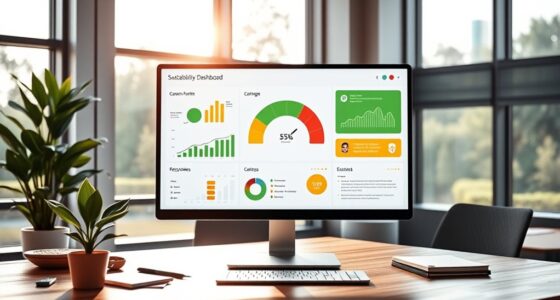Guest Wi‑Fi analytics give you valuable insights into visitor demographics, behaviors, and network performance. You can track device types, movement patterns, and peak usage times to optimize your Wi‑Fi setup and improve guest experiences. This data also helps tailor marketing efforts and manage network capacity more effectively. By understanding these metrics, you can make smarter decisions for your business. Continue exploring to discover how to use this data responsibly and maximize its benefits.
Key Takeaways
- Provides insights into visitor demographics, behavior, and device types to optimize guest experiences.
- Tracks movement, stay durations, and traffic patterns for space utilization and infrastructure planning.
- Monitors network performance metrics like bandwidth, latency, and signal strength to ensure reliable connectivity.
- Enables targeted marketing by analyzing browsing habits, visit times, and guest preferences.
- Ensures data security and privacy compliance through encryption, transparency, and guest consent.
Understanding Guest Wi‑Fi Analytics and Its Benefits

Understanding guest Wi‑Fi analytics is essential because it provides valuable insights into who your visitors are and how they interact with your network. By analyzing this data, you can identify patterns in visitor behavior, peak usage times, and device types. This information helps you optimize your Wi‑Fi setup, improve user experience, and tailor marketing efforts. For example, if analytics show most visitors connect during certain hours, you can plan staff schedules accordingly. You also gain a better understanding of your audience, which can guide your business decisions. Plus, real-time insights enable quick responses to connectivity issues, enhancing customer satisfaction. Incorporating comfort and support solutions can also improve the overall environment for your visitors. Overall, leveraging guest Wi‑Fi analytics transforms raw connection data into actionable strategies that benefit both your visitors and your operations.
Collecting and Securing Guest Data Responsibly

Collecting guest data responsibly is essential to maintaining trust and complying with privacy regulations. You should clearly inform guests about what data you collect, how you’ll use it, and obtain their consent. Use secure methods to gather and store information, such as encrypted networks and protected databases. Limit data collection to only what’s necessary for improving their experience and your network management. Regularly review your privacy policies to ensure they meet current laws like GDPR or CCPA. Train your staff on responsible data handling to prevent breaches. Remember, transparency and security build guest confidence and protect your reputation. By prioritizing responsible data collection, you demonstrate respect for your guests’ privacy while gaining valuable insights. Incorporating data privacy best practices helps reinforce your commitment to security and compliance.
Analyzing User Behavior and Movement Patterns

You can gain valuable insights by tracking device movement trends and identifying high traffic areas. This helps you understand where guests spend most of their time and when they visit certain spots. Analyzing stay duration further reveals guest engagement and areas for improvement.
Tracking Device Movement Trends
Tracking device movement trends provides valuable insights into how users navigate your space, revealing patterns that can inform better resource allocation and service placement. By analyzing movement data, you can identify which areas see the most foot traffic and when. This helps you optimize Wi-Fi access point placement for stronger signals and improved connectivity. You might discover peak times when certain zones are busier, allowing you to adjust staffing or resources accordingly. Monitoring movement also highlights areas where visitors tend to linger or pass through quickly. These insights enable you to design a more efficient layout, improve user experience, and ensure Wi-Fi performance aligns with user behavior. Implementing heat mapping techniques can further enhance your understanding of device movement patterns. Ultimately, tracking device movement trends helps you make data-driven decisions to enhance your space’s functionality.
Identifying High Traffic Areas
Analyzing user behavior and movement patterns reveals which areas in your space attract the most foot traffic. By examining Wi-Fi connection data, you can identify hotspots where guests tend to gather or pass through frequently. This insight helps you optimize space usage, such as positioning seating, displays, or signage in high-traffic zones to maximize engagement. You might notice certain corridors or corners see more activity, indicating their importance in guest flow. Understanding these patterns allows you to allocate resources effectively, improve layout design, and enhance overall guest experience. Keep in mind, consistent monitoring over time reveals shifts in traffic, helping you adapt to changing behaviors. Additionally, incorporating principles of biodiversity into your space design—such as creating inviting natural areas—can further encourage positive interactions and improve guest satisfaction. Ultimately, this targeted approach ensures you make data-driven decisions that boost both operational efficiency and guest satisfaction.
Analyzing Stay Duration
Understanding how long guests stay in different areas provides valuable insights into their engagement and preferences. By analyzing stay durations, you can identify which spaces attract more prolonged visits and which are only briefly passed through. This helps you optimize your layout, improve amenities, or adjust staffing accordingly. Longer stays may indicate areas of high interest or comfort, while shorter visits could highlight less engaging zones. Tracking patterns over time reveals peak times and seasonal shifts in visitor behavior. If you notice guests tend to leave quickly after a certain point, it might signal a need to enhance that space’s appeal. Ultimately, analyzing stay duration enables you to make data-driven decisions to enhance guest experience and operational efficiency.
Personalizing Guest Experiences Through Data Insights

By harnessing data insights from guest Wi-Fi networks, you can tailor your offerings to meet individual preferences and boost overall satisfaction. Analyzing browsing habits, visit times, and device types helps you understand what guests value most. For example, if data shows a guest frequently visits local attractions or restaurants, you can offer personalized recommendations or discounts. Using this information, you can customize marketing messages, suggest relevant services, or adjust amenities to align with guest interests. Personalization makes guests feel recognized and valued, encouraging loyalty and positive reviews. It also provides opportunities to enhance their experience proactively, whether through targeted promotions or tailored service offerings. Understanding privacy policies and ensuring compliance is crucial when collecting and analyzing guest data. Overall, leveraging data insights transforms your guest interactions from generic to personalized, creating memorable experiences that set you apart.
Monitoring Network Usage and Performance Metrics

To optimize your guest Wi‑Fi, you need to monitor key metrics like bandwidth consumption trends and peak usage times. Tracking connection quality metrics helps you identify potential issues before they affect guests. Understanding these data points enables you to improve network performance and deliver a seamless experience. Additionally, analyzing performance cookies can provide insights into how your network infrastructure supports user demands.
Bandwidth Consumption Trends
Monitoring bandwidth consumption trends is essential for maintaining ideal network performance when managing guest Wi‑Fi. By tracking how much data your guests use over time, you identify usage patterns and spot potential issues early. You can see which devices or applications consume the most bandwidth, helping you allocate resources effectively. This insight allows you to prevent network congestion, ensuring a smooth experience for all users. Regular analysis of bandwidth trends also helps you plan upgrades or optimize existing infrastructure. Additionally, understanding consumption patterns reveals whether guest traffic is stable or fluctuates, enabling better capacity management. Monitoring these trends can also inform decisions about network infrastructure investments to support future growth. Ultimately, monitoring these trends empowers you to make data-driven decisions that improve overall network reliability and guest satisfaction.
Peak Usage Times
Understanding peak usage times is essential for optimizing your guest Wi‑Fi performance. By analyzing when your network experiences the highest traffic, you can allocate resources more effectively and prevent congestion. Look for patterns in your analytics to identify busy hours daily or weekly, such as lunch breaks or evening events. Knowing these times allows you to adjust bandwidth allocation or schedule maintenance during off-peak periods, minimizing disruptions. Monitoring usage trends also helps you anticipate future demand, ensuring your network scales appropriately. Keep an eye on real-time data to respond quickly to unexpected spikes, preventing slowdowns or outages. Additionally, tracking cruise destination activities can help predict guest connectivity needs during popular events. Ultimately, understanding peak usage times enables you to deliver a smoother, more reliable Wi‑Fi experience for your guests.
Connection Quality Metrics
Tracking connection quality metrics is crucial for maintaining ideal guest Wi-Fi performance. These metrics include signal strength, latency, jitter, and packet loss, which directly impact user experience. By monitoring signal strength, you can identify areas with weak coverage and optimize router placement or add access points. Latency measures the delay in data transmission, helping you spot network congestion or slow responses. Jitter indicates variability in latency, affecting streaming and VoIP calls. Packet loss reveals data that fails to reach its destination, causing interruptions. Regularly reviewing these metrics allows you to troubleshoot issues quickly, guarantee stable connections, and deliver a seamless guest experience. Optimizing network performance requires understanding these metrics, which ultimately helps you fine-tune your network for reliability and high performance.
Leveraging Data for Marketing and Promotional Strategies

By analyzing guest Wi-Fi data, you can identify customer preferences and behaviors that inform targeted marketing efforts. For example, you can discover peak visit times, popular locations within your venue, and common browsing patterns. This insight helps you personalize offers, send timely promotions, and craft campaigns that resonate with your guests. You might recognize frequent visitors or high-value customers, enabling you to reward loyalty or upsell relevant products and services. Additionally, understanding what guests search for online allows you to tailor your advertising to meet their specific interests. Recognizing guest preferences through data can further refine your marketing strategies. Leveraging this data guarantees your marketing efforts are efficient and effective, fostering stronger customer relationships and increasing revenue. Ultimately, data-driven marketing helps you deliver more relevant content, enhancing guest satisfaction and encouraging repeat business.
Ensuring Privacy Compliance and Building Guest Trust

As you collect and analyze guest Wi-Fi data, prioritizing privacy compliance is essential to maintain trust and avoid legal issues. Guests want to feel confident their information is protected. To guarantee compliance and build trust, focus on transparency, secure data storage, and clear communication. Make sure your policies align with regulations like GDPR or CCPA. Obtain explicit consent before collecting data, and give guests options to opt out. Regularly audit your data practices and staff training. Additionally, anonymize data whenever possible to protect guest identities.
- Clearly communicate your data collection practices
- Obtain explicit guest consent
- Use encryption and secure storage methods
- Offer easy opt-out options
- Regularly review compliance policies
Frequently Asked Questions
How Do Guest Wi‑Fi Analytics Differ From Traditional Wi‑Fi Management Tools?
Guest Wi‑Fi analytics differ from traditional Wi‑Fi management tools because they focus on understanding guest behavior and usage patterns. While traditional tools mainly monitor network performance and security, guest analytics provide insights into visitor demographics, device types, and connection times. This data helps you tailor marketing efforts, improve guest experiences, and optimize network resources, making your Wi‑Fi service more effective and guest-friendly.
What Are the Best Practices for Anonymizing Guest Data?
When you anonymize guest data, you protect user privacy while still gaining valuable insights. You should remove personally identifiable information, use encryption, and apply data masking techniques. Regularly review your practices to guarantee compliance with privacy laws like GDPR or CCPA. Also, limit data access to authorized staff and implement secure storage methods. By following these best practices, you maintain trust and avoid potential legal issues.
How Can Analytics Predict Future Guest Behavior Trends?
Did you know that 70% of travelers are more likely to revisit brands that personalize their experience? When you analyze guest Wi-Fi data, you can spot patterns like peak usage times or popular amenities. By tracking these behaviors over time, you can predict future guest preferences and trends. This helps you tailor services proactively, boosting satisfaction and loyalty. Using data-driven insights, you stay ahead in the competitive hospitality landscape.
What Are Common Challenges in Implementing Guest Wi‑Fi Analytics?
You might face challenges like data privacy concerns and securing guest consent. Implementing analytics requires integrating systems smoothly, which can be technically complex. Ensuring data accuracy and managing large data volumes also pose hurdles. Additionally, you need staff training to interpret insights correctly. Overcoming these issues involves clear policies, robust security measures, and ongoing staff education to fully leverage guest Wi-Fi analytics benefits.
How Do Analytics Influence Long-Term Customer Loyalty Strategies?
Imagine your customer data as a treasure map guiding your loyalty strategies. Analytics reveal patterns in guest behavior, preferences, and engagement, helping you craft personalized experiences that keep customers coming back. You can identify what works and refine your approach. By leveraging these insights, you build stronger relationships, foster trust, and boost retention. Essentially, analytics turn data into a powerful tool for cultivating long-term customer loyalty.
Conclusion
Think of guest Wi‑Fi analytics as your trusted compass, guiding you through a bustling marketplace of guest insights. With each data point, you navigate better, crafting experiences that feel personalized and seamless. When you respect privacy and build trust, you’re not just charting a course—you’re creating a welcoming oasis where guests feel valued. Embrace these insights, and watch your hospitality journey flourish like a well-tended garden.









